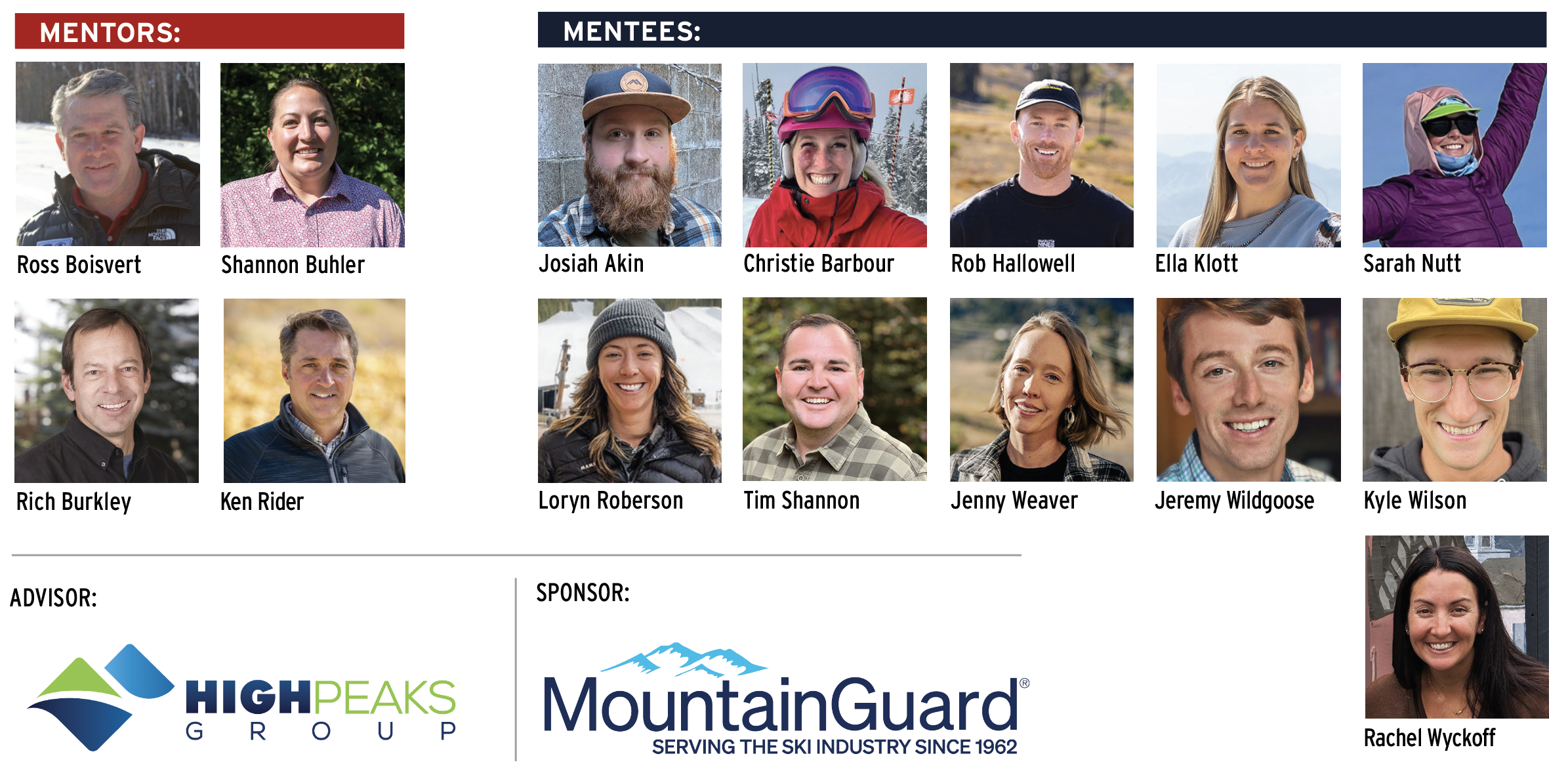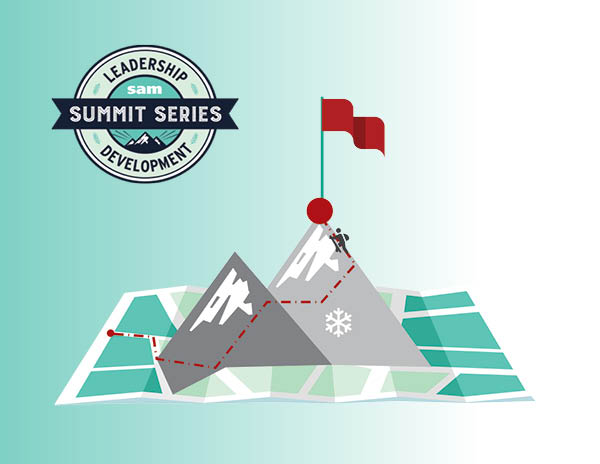Mindset is a powerful thing. It influences our behavior, decision-making, communication, and confidence. It can be the key to our success, or our primary limiting factor. And it doesn’t just affect us as individuals—those personal feelings can permeate the entire work environment, for better or worse. That’s why it’s important for leaders to be mindful of their mindset.
Mindset is about “getting to an understanding of your personal core values, your deepest held priorities. Because leadership is a nonstop conveyor belt of decision making, and what gives clarity to decision making is, ‘do I understand what I value most?’” said Stu Singer, CEO of Well Performance, during a fall 2024 SAM Summit Series leadership development session on “Mastering Your Mindset.”
Singer, a sports psychology and performance consultant, was the guest expert for the session, which brought together 11 up-and-coming industry leaders and four mentors—Shannon Buhler, vice president and general manager of Keystone Resort in Colorado; Rich Burkley, CEO of Lake Louise Ski Resort in Alberta; Ken Rider, general manager of Brundage Mountain in Idaho; and Ross Boisvert, president and general manager of McIntyre Ski Area in New Hampshire. The conversation was facilitated by High Peaks Group founder Paul Thallner.
Together, this group examined how mindset can help leaders learn from mistakes (and not fear them), be clear on communication, and navigate stress and uncertainty.
SAM’s Summit Series leadership development platform offers mountain resort professionals at all levels the opportunity to learn from industry leaders, peers, and experts, and gain tangible takeaways to apply to their careers, operations, and teams. Learn more at saminfo.com/the-summit-series.

Modeling a Growth Mindset
Anyone who’s touched the tip of the iceberg of self-improvement knows the value of a growth mindset for career development. While a fixed mindset isn’t willing to confront challenges in a way that promotes personal growth, a growth mindset pushes through mistakes, setbacks, and challenges with a commitment to learning from them as a means of getting better. A fixed mindset remains stagnant in what it knows, while a growth mindset craves a lifetime of learning.
A workplace culture that’s centered on a growth mindset is one where team members don’t fear failure. “Nobody wants to make a mistake,” said Boisvert. “They’re all there to impress their bosses, impress you, and climb the ladder of whatever resort they’re at.” That’s why, he said, leaders should approach missteps “with a level head and understanding that it was not intentional.”
“From a leadership perspective, you can’t ask somebody to have a growth mindset and then punish them immediately for taking good risks or doing something outside of their comfort zone,” Singer agreed. “That is where the growth mindset gets messed up.”
Learn from failure. Rider approaches employee mistakes as opportunities for “a mini incident review.” He suggests asking: “What did you do? How did it make you feel? What was the outcome? Was the outcome intended?” These kinds of questions help team members develop self-awareness, examine risks, and apply lessons going forward.
Leaders also need to model learning from failure, said Singer. The best leaders recognize that they are imperfect, just like everyone else, and are open about the lessons they’ve learned along the way. They can admit, “I didn’t [get here] because I was getting it right all the time,” he said.
Boisvert echoed that: “I think it’s important that we remember where we came from, and how we started, and how we got to where we are. I can say I make mistakes every day. We all do.”
Such modeling helps foster a team philosophy that recognizes and values mistakes as part of leadership, and encourages employees to understand the dance between the desire to get it right and the growing pains—and learning opportunities—involved in getting it wrong.
And the learning process is never-ending. “You’re not supposed to know it all at 30 years old,” said Singer. “Not at 55 either.” Remembering that is key to continued growth.
Lessons From the Hill
Mistakes are crucial to learning, and the mentors have all had missteps in their careers that have helped shaped their mindset and leadership approach.
Remember your team. Rider shared how early-career tunnel vision caused him to lose sight of his team’s needs. “I was so focused on what my performance goals were that I was ignoring some of my team members and how my actions impacted them,” he said. He did care about his team but that wasn’t coming across to them: “I wasn’t bringing the team along.”
The fix? “We need to be vulnerable and show that vulnerability to our team.”
Shift your mindset. Buhler reflected on a time when she stepped into a familiar role at a new resort. She expected it to be a smooth transition. “I went in thinking I knew all the answers, and if they weren’t doing it the way I thought it should be done, that we should change it. And it was very clear that was not what I needed to be doing. I needed to listen and to learn … and realize that a different approach can reach the same results.”
That prompted a shift in mindset. Earlier in her career, “failing wasn’t an option,” she said. “Willingness to fail was something that I had to learn along the way.”
Ask questions. Even seasoned leaders have blind spots. Despite his years of resort leadership experience, Burkley admitted he hadn’t spent enough time learning about technology systems. “I am now getting punished for my lack of knowledge and lack of depth on those systems when my IT guy comes in and starts spouting jargon off, and I’m like, ‘whoa, whoa, whoa.’”
The key to overcoming gaps in knowledge, he said, is honesty and curiosity. “I have no expertise there ... and the way I overcame it was acceptance that I don’t have it. So, I get the experts in and ask the questions.”
Boisvert echoed that advice: “My gremlins are always there, but I surround myself with people that are way smarter than I am. I think that when you do that, you are able to share ideas openly and make better educated decisions.”
Communication that Connects
According to Singer, a good leader knows their industry inside and out, but a great leader can share that knowledge with their teammates. That depends on strong communication skills.
For each industry, he said, “there’s kind of an ‘industry playbook.’ You have to know the X’s and O’s of your industry. » But the differentiator is in the ability to communicate those X’s and O’s, or that ‘playbook’—the industry information.” The best of the best know the valuable information, and are able to share that knowledge in a way that not only says, “I get it,” but allows their teammates to get it as well.
Learn to listen. Good communication has two parts, said Singer. The first part is the ability to convey a message, mission, or goal. The second part is the ability to listen. And one feeds the other. “I think the reason that great leaders are good at the delivery of information is because they’re willing to listen first,” he said. “So, they understand what their teams need or what the individuals they’re leading need, and when they articulate their message, it lands.”
Buhler added that in effective communication, teams understand not just the “what” but the “why.” If someone ignores your guidance, she said, “maybe you didn’t explain the why strongly enough, and you didn’t create that buy-in initially. So, now’s the opportunity to go back and say, ‘Hey, look at what we learned from this. Let me explain the why in a different way.’”
Leading with Core Values
What takes leaders off their game? “The universal answer to that is uncertainty,” said Singer.
In the face of uncertainty, core values are a steadying force, he said. When a leader is in touch with their values, all decisions filter down from there. Knowing your core values “does not necessarily make hard decisions easy, it just makes them clearer,” said Singer.
He recalled how his own mindfulness practice helped during the uncertainty of the early days of the pandemic. Tapping into gratitude allowed him to make decisions without spiraling. “That gave me enough room to breathe and some space to think,” he said. “Having an understanding of core values—and my mindfulness practice was a big part of that—gave me the ability to be present and not get too far out ahead where anxiety lives.”
Stay grounded. Each leader has their own way of staying grounded. For Burkley, it’s getting out on the hill every day: “even riding a chairlift resets the whole day for me.” For Boisvert it is family and knowing “where I came from.” Some have a daily routine, while others are rooted through mentoring the next generation with, say, a weekly interdepartmental breakfast.
Whatever “it” is, these leaders recommend finding it and holding it close. When leaders identify and nourish core values, they can remain firmly rooted in their identity while also examining and sharing the ups and downs of their careers. That doesn’t just benefit the leader—it benefits the entire team.
Because at the end of the day, mindset isn’t just about positivity. It’s about presence, self-awareness, and the willingness to learn.






